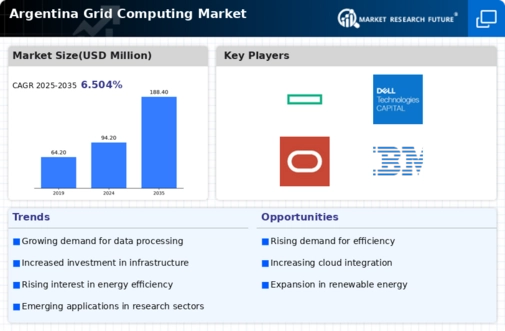Emergence of Big Data Analytics
The emergence of big data analytics is significantly influencing the grid computing market in Argentina. Organizations are increasingly leveraging big data to gain insights and make informed decisions, which necessitates the use of grid computing technologies for efficient data processing and analysis. The ability to handle vast amounts of data in real-time is becoming a critical requirement for businesses across various sectors. Recent studies indicate that the big data analytics market in Argentina is projected to grow by approximately 20% annually, which could lead to a corresponding increase in the demand for grid computing solutions. This trend suggests that as companies seek to harness the power of big data, they will likely turn to grid computing for its scalability and processing capabilities, thereby driving growth in the market.
Rising Demand for High-Performance Computing
The grid computing market in Argentina is seeing a significant increase in demand for high-performance computing (HPC) solutions.. This trend is driven by the increasing need for complex data analysis across various sectors, including finance, healthcare, and scientific research. As organizations seek to enhance their computational capabilities, the grid computing market is positioned to provide scalable and efficient solutions. According to recent estimates, the HPC segment is expected to grow at a CAGR of approximately 15% over the next five years. This growth indicates a robust appetite for advanced computing resources, which grid computing can effectively deliver. Furthermore, the integration of HPC with grid computing technologies allows for improved resource utilization, thereby optimizing operational costs and enhancing productivity in the Argentine market.
Increased Focus on Data Security and Compliance
As data breaches and cyber threats become more prevalent, the grid computing market in Argentina is witnessing an increased focus on data security and compliance. Organizations are recognizing the importance of safeguarding sensitive information, which has led to a demand for secure grid computing solutions. The market is responding by integrating advanced security protocols and compliance measures into grid computing frameworks. According to industry reports, approximately 70% of Argentine companies are prioritizing data security in their IT strategies, which is likely to drive investments in secure grid computing technologies. This emphasis on security not only protects organizational data but also enhances customer trust, thereby fostering a more robust grid computing market. As compliance with local and international regulations becomes more stringent, the demand for secure grid computing solutions is expected to rise.
Collaboration Among Academic and Research Institutions
Collaboration among academic and research institutions is playing a pivotal role in shaping the grid computing market in Argentina. Universities and research centers are increasingly recognizing the potential of grid computing to facilitate collaborative research and resource sharing. This trend is fostering innovation and the development of new applications that leverage grid computing technologies. For instance, joint research projects are being established to explore advanced computational methods, which could lead to breakthroughs in various fields such as climate modeling and bioinformatics. The Argentine government has also been supportive of these collaborations, providing funding and resources to enhance research capabilities. As these partnerships continue to grow, they are likely to contribute to the expansion of the grid computing market, driving advancements in technology and application development.
Government Initiatives Supporting Technological Advancement
In Argentina, government initiatives aimed at fostering technological advancement are significantly impacting the grid computing market. The Argentine government has launched various programs to promote research and development in information technology, which includes funding for grid computing projects. These initiatives are designed to enhance the country's technological infrastructure and encourage innovation. For instance, the government has allocated approximately $50 million to support IT research, which is likely to stimulate growth in the grid computing sector. Additionally, partnerships between public institutions and private enterprises are being encouraged, creating a collaborative environment that could lead to the development of cutting-edge grid computing solutions. This supportive regulatory framework is expected to drive the adoption of grid computing technologies across multiple industries in Argentina.















Leave a Comment